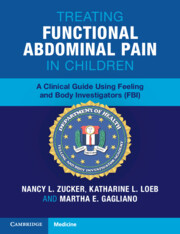 Treating Functional Abdominal Pain in Children
Treating Functional Abdominal Pain in Children Book contents
- Treating Functional Abdominal Pain in Children
- Treating Functional Abdominal Pain in Children
- Copyright page
- Dedication
- Contents
- Acknowledgements
- Part I The Background Science Behind Feeling and Body Investigators
- Part II A Session-by-Session Guide to Feeling and Body Investigators
- Chapter 6 Session 1: Initiation into Feeling and Body Investigators
- Chapter 7 Session 2: The Eats
- Chapter 8 Session 3: The Explosions
- Chapter 9 Session 4: The Zoomies and the Shakies, Part 1
- Chapter 10 Session 5: The Blahs
- Chapter 11 Session 6: The Ouchies
- Chapter 12 Session 7: The Drowsies
- Chapter 13 Session 8: The Zoomies and the Shakies, Part 2
- Chapter 14 Session 9: The Soothies
- Chapter 15 Session 10: The Celebration… and the Next Leg of Our Journey
- Part III Sample Workbook Pages, Handouts, and Additional Resources for Feeling and Body Investigators
- Index
- References
Chapter 12 - Session 7: The Drowsies
from Part II - A Session-by-Session Guide to Feeling and Body Investigators
Published online by Cambridge University Press: 18 November 2023
- Treating Functional Abdominal Pain in Children
- Treating Functional Abdominal Pain in Children
- Copyright page
- Dedication
- Contents
- Acknowledgements
- Part I The Background Science Behind Feeling and Body Investigators
- Part II A Session-by-Session Guide to Feeling and Body Investigators
- Chapter 6 Session 1: Initiation into Feeling and Body Investigators
- Chapter 7 Session 2: The Eats
- Chapter 8 Session 3: The Explosions
- Chapter 9 Session 4: The Zoomies and the Shakies, Part 1
- Chapter 10 Session 5: The Blahs
- Chapter 11 Session 6: The Ouchies
- Chapter 12 Session 7: The Drowsies
- Chapter 13 Session 8: The Zoomies and the Shakies, Part 2
- Chapter 14 Session 9: The Soothies
- Chapter 15 Session 10: The Celebration… and the Next Leg of Our Journey
- Part III Sample Workbook Pages, Handouts, and Additional Resources for Feeling and Body Investigators
- Index
- References
Summary
The Drowsies is our session about sleep. As a restful night of sleep is an important part of any pain management routine, we wanted to devote a session just to that. We explore that sensations that make it hard to get into bed (e.g., Stuck Stephanie – the feeling that you can’t stop doing something that you like doing (like playing video games) to do something you would rather not do (like get ready for bed). We remember some old friends that that may make it hard to fall asleep like Mind-Racing Mikella and Betty Butterfly and we investigate all the sensations that may contribute to a wonderful and cozy night of rest. Cozy Celeste, Sleepy Steven, Cool Cyrus, and Stretched-Out Comfy Cayla are some sensations we explore this session. Wait till you try out all of our different bedtime routines!
Keywords
- Type
- Chapter
- Information
- Treating Functional Abdominal Pain in ChildrenA Clinical Guide Using Feeling and Body Investigators (FBI), pp. 106 - 115Publisher: Cambridge University PressPrint publication year: 2023


